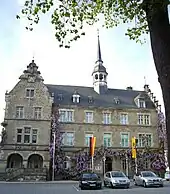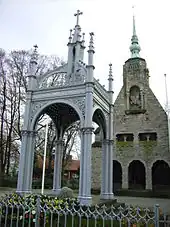Lützen
municipality of Saxony-Anhalt, Germany
Lützen is a town with about 3600 inhabitants in Saxony-Anhalt in Germany.

Lützen town hall
Understand

King Gustavus Adolphus of Sweden in the Battle of Lützen 1632 (painting by Jan Asselijn, 1635, displayed in the Berlin Gemäldegalerie)
Two great battles were fought near the town.
The 1632 Battle of Lützen was part of the Thirty Years War. King Gustavus Adolphus led Sweden to victory against the Habsburg army, but died on the battlefield. The campaign was decisive for leading the Swedish Empire to victory.
The 1813 Battle of Lützen was part of the Napoleonic Wars.
Get in
The train line to Lützen has been suspended, so you can take the bus from nearby Leipzig or get to Lützen by car. To get there by bus from Leipzig, take a train or bus 65 to Markranstädt, Bahnhof and change there to bus 165.
Get around
The town is quite small, so it is easy to get around by foot.
See

Gustavus Adolphus monument and memorial chapel
- 🌍 Gustavus Adolphus memorial, Gustav-Adolf-Straße 42 (2 km from the town center along the road towards Leipzig), ☏ +49 34444 203-17, museum.luetzen@gmx.de. Tu-Su 10:00-17:00. The Swedish king Gustavus II Adolphus died in the battle of 1632, therefore most of the tourists visiting the town are Swedes. Initially the memorial just consisted of a granite boulder placed at the place where the fallen king's body was found. During a revival of veneration for Gustavus Adolphus in 19th-century Protestant Prussia, a baldachin designed by Karl Friedrich Schinkel (architect of many representative buildings in central Berlin) was added in 1833. The neighbouring Gustavus Adolphus chapel was endowed by the Swedish consul to Germany in 1907. There was an urban legend in East Germany that the memorial was an extraterritorial enclave of the Kingdom of Sweden, but there is no truth in it.
- Lützen castle, Schlossstraße 4, ☏ +49 34444 202-28, fax: +49 34444 906 93, museum.luetzen@gmx.de. Tu-Su 10:00-17:00. 13th-century castle built for the bishops of Merseburg. It hosts a museum of local and regional history, focusing on the two battles.
- The town hall, Markt 1. Built in 1884/1885, Renaissance revival style.
%252C_the_birthplace_of_Friedrich_Nietzsche.jpg.webp)
Parsonage of Röcken – Nietzsche's birthplace
- 🌍 Friedrich Nietzsche's birthplace, Röcken, Teichstraße 8 (2.5 km southwest of the town core, on the road to Weißenfels), ☏ +49 34444 169705. November–March: W-Sa 10:00-16:00, occasionally opened on Sundays and holidays (see website). World-famous philosopher Friedrich Nietzsche (1844–1900) was born in the parsonage of Röcken (as his father was the Lutheran pastor of that village). The father died when young Friedrich was five and the family moved to nearby Naumburg where there is a more comprehensive Nietzsche museum and archive. The memorial complex consists of the birth house, the church where Nietzsche was christened, his tomb and a modern group of sculptures ("Bacchanal"). The small exhibition (three rooms) was modernised in 2003 and deals with his childhood, his relationship with Christianity, and the history of his tomb. (updated Nov 2016)
Do
- 🌍 Sommerbad Lützen, Merseburger Str. 1b, ☏ +49 34444 21585. During the season: daily 10:00-20:00.
Eat
- 🌍 Roter Löwe, Ernst-Thälmann-Straße 9, ☏ +49 34444 23332.
Drink
Sleep
- 🌍 Hotel Pension Köper, Ernst-Thälmann-Straße 25, ☏ +49 34444 3060.
Connect
Nearby
- Central German lake district, recultivated landscape of former lignite open-cast mines turned into lakes: Kulkwitzer See is 10 km northeast, Zwenkauer See 13 km east, Raßnitzer See 15 km north of Lützen
Go next
- Leipzig, 20 km northeast, trade city, cultural metropolis and economic "boom town" of East Germany, the obvious next step for history buffs is the Monument to the Battle of the Nations
- Merseburg, 20 km northwest, more than thousand-year-old town with interesting old centre, Romanesque/Gothic cathedral and Renaissance palace, long-standing chemical industry site
- Naumburg, 35 km southwest, impressive Romanesque cathedral, Friedrich Nietzsche museum and archive, centre of the Saale-Unstrut cultural landscape and wine-growing region
- Halle, 40 km north, largest city in Saxony-Anhalt, interesting old town, birthplace of George Frideric Handel, castles on the river Saale
This article is issued from Wikivoyage. The text is licensed under Creative Commons - Attribution - Sharealike. Additional terms may apply for the media files.